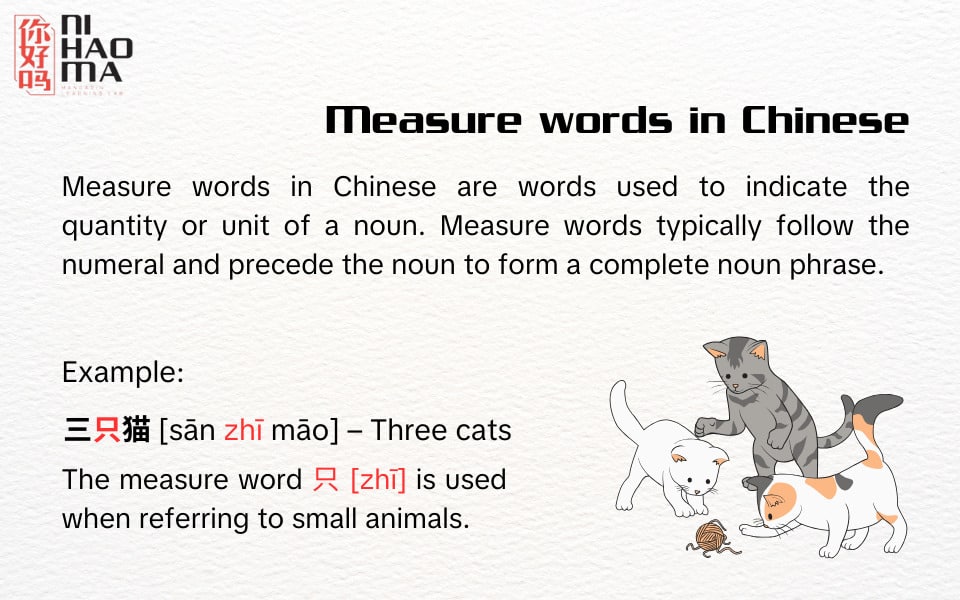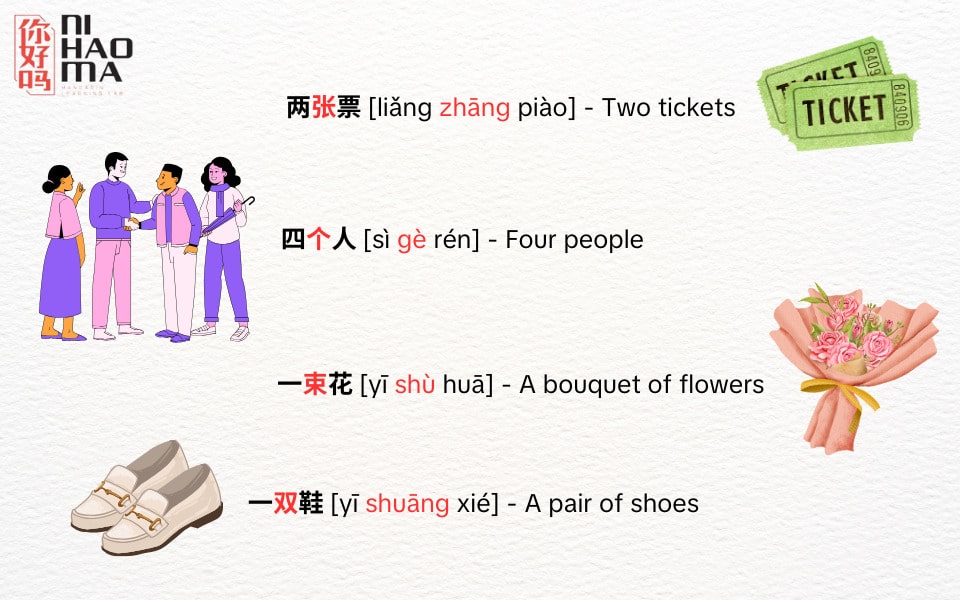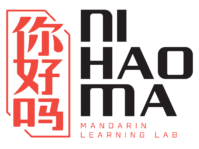Mastering Chinese measure words is a key step toward speaking fluently and naturally in Chinese. Chinese nouns typically require specific measure words that match the type of the item being discussed. In this post, we will explore essential Chinese measure words, explaining their usage and importance in real-life contexts.
What are Chinese measure words?
Chinese measure words or 量词 (liàngcí) are words used to quantify nouns, similar to units or classifiers in English.

Chinese measure words, also known as classifiers, are words that specify the quantity or type of a noun. They are used to clarify the meaning of a sentence and make it more precise. Unlike English, where general quantifiers like “a piece of” or “a pair of” are used only occasionally, Chinese requires a measure word almost every time you count or quantify something.
How to use Chinese measure words?
Using the correct measure word in Chinese not only makes your sentences accurate but also helps them sound more natural. Chinese measure words are typically placed between numerals (like 一 yī – “one” or 两 liǎng – “two”) and nouns to indicate quantity or specify the nature of an object. The structure for sentences with measure words is as follows:
Numeral + Measure Word + (Adjective) + Noun
Examples:
- 一个学生 (yī gè xuéshēng): One student
- 一条河 (yī tiáo hé): One river
- 五本新书 (wǔ běn xīn shū): Five new books
- 一张桌子 (yī zhāng zhuōzi): One table
This structure brings clarity and precision to descriptions, essential for fluent Chinese communication.
Important Points to Remember About Chinese Measure Words
Chinese measure words have several essential characteristics you should remember to use them accurately:
1. Specificity and Categorization
Chinese measure words are highly specific and categorized for certain types of nouns, meaning they are not interchangeable. Each measure word is associated with a specific group of objects.

2. Cannot Be Omitted
When expressing quantity, the measure word is required and cannot be skipped. For example, to say “three people,” a measure word must be included: 三个人 (sān gè rén), not just 三人 (sān rén).
3. Can Stand Alone in Short Responses
Measure words in Chinese can stand alone in some contexts, particularly when expressing an indefinite quantity or when the subject is understood. For example:
A: 几个? (jǐ gè?) – “How many?”
B: 两个。 (Liǎng gè.) – “Two.”
4. Measure Words Can Be Repeated
In Chinese, repeating a measure word can convey specific meanings. Repetition may emphasize quantity, indicate gradual progression, or highlight individual elements. For example:
一个一个 (yī gè yī gè): one by one, each one (often implies step-by-step action).
一点一点 (yī diǎn yī diǎn): bit by bit, gradually (suggesting slow or careful progression).
个个 (gè gè): each person, everyone (emphasizes that all members in a group are being referenced individually).
Common Chinese measure words
Chinese measure words are varied and complex. Generally, they can be categorized as follows:
- General measure words: 个 (gè) – used for a wide range of nouns.
- Object-specific measure words: 本 (běn) – for books; 张 (zhāng) – for flat objects like paper or tables; 条 (tiáo) – for long, thin items like rivers or roads.
- People-specific measure words: 位 (wèi) – for people (in polite contexts); 名 (míng) – for people (used in statistical contexts).
- Animal-specific measure words: 只 (zhī) – for small animals; 头 (tóu) – for large animals.
Below is a detailed table of common Chinese measure words along with usage examples:
| Measure Word | Pinyin | Used For | Example (English) |
|---|---|---|---|
| 个 | gè | General items, people | 三个人 (sān gè rén) – three people |
| 本 | běn | Books, bound volumes | 一本书 (yī běn shū) – a book |
| 张 | zhāng | Flat objects | 一张纸 (yī zhāng zhǐ) – a sheet of paper |
| 条 | tiáo | Long, narrow things | 一条鱼 (yī tiáo yú) – a fish |
| 只 | zhī | Small animals, some objects | 一只猫 (yī zhī māo) – a cat |
| 位 | wèi | People (polite) | 一位老师 (yī wèi lǎoshī) – a teacher |
| 杯 | bēi | Cups, glasses of liquid | 一杯水 (yī bēi shuǐ) – a glass of water |
| 支 | zhī | Long, thin items | 一支笔 (yī zhī bǐ) – a pen |
| 颗 | kē | Small, round objects | 一颗糖 (yī kē táng) – a candy |
| 台 | tái | Machines, electronics | 一台电脑 (yī tái diànnǎo) – a computer |
| 架 | jià | Planes, pianos | 一架飞机 (yī jià fēijī) – a plane |
| 本 | běn | Trees | 一棵树 (yī kē shù) – a tree |
| 堂 | táng | Classes, lessons | 一堂课 (yī táng kè) – a class |
| 件 | jiàn | Clothes, matters | 一件衣服 (yī jiàn yīfú) – a piece of clothing |
| 双 | shuāng | Pairs (e.g., shoes) | 一双鞋 (yī shuāng xié) – a pair of shoes |
| 头 | tóu | Large animals | 一头牛 (yī tóu niú) – a cow |
| 轮 | lún | Round items (e.g., matches) | 一轮比赛 (yī lún bǐsài) – a match |
| 页 | yè | Pages | 一页纸 (yī yè zhǐ) – a page |
| 瓶 | píng | Bottles | 一瓶水 (yī píng shuǐ) – a bottle of water |
| 份 | fèn | Portions, servings | 一份饭 (yī fèn fàn) – a serving of rice |
| 座 | zuò | Large structures, mountains | 一座山 (yī zuò shān) – a mountain |
| 道 | dào | Questions, orders | 一道题 (yī dào tí) – a question |
| 栋 | dòng | Buildings | 一栋房子 (yī dòng fángzi) – a building |
| 首 | shǒu | Songs, poems | 一首歌 (yī shǒu gē) – a song |
| 场 | chǎng | Events, shows | 一场电影 (yī chǎng diànyǐng) – a movie showing |
| 节 | jié | Segments, lessons | 一节课 (yī jié kè) – a lesson |
| 串 | chuàn | Things in a string | 一串葡萄 (yī chuàn pútao) – a bunch of grapes |
| 群 | qún | Groups, crowds | 一群人 (yī qún rén) – a group of people |
| 层 | céng | Layers, floors | 一层楼 (yī céng lóu) – a floor (of a building) |
| 篇 | piān | Articles, writings | 一篇文章 (yī piān wénzhāng) – an article |
| 句 | jù | Sentences | 一句话 (yī jù huà) – a sentence |
| 块 | kuài | Pieces, chunks | 一块蛋糕 (yī kuài dàngāo) – a piece of cake |
| 种 | zhǒng | Types, kinds | 一种水果 (yī zhǒng shuǐguǒ) – a type of fruit |
| 封 | fēng | Letters (correspondence) | 一封信 (yī fēng xìn) – a letter |
| 遍 | biàn | Times (frequency) | 一遍 (yī biàn) – once (one time through) |
| 片 | piàn | Slices, tablets | 一片药 (yī piàn yào) – a tablet (of medicine) |
| 面 | miàn | Flat surfaces | 一面镜子 (yī miàn jìngzi) – a mirror |
| 杯 | bēi | Cups (repeated to show two examples) | 一杯咖啡 (yī bēi kāfēi) – a cup of coffee |
| 丝 | sī | Strands | 一丝希望 (yī sī xīwàng) – a trace of hope |
| 幅 | fú | Paintings, pictures | 一幅画 (yī fú huà) – a painting |
| 张 | zhāng | Cards, tickets | 一张票 (yī zhāng piào) – a ticket |
| 圆 | yuán | Rounds, circular items | 一圆硬币 (yī yuán yìngbì) – a coin |
| 把 | bǎ | Handfuls, tools | 一把刀 (yī bǎ dāo) – a knife |
| 盒 | hé | Boxes, cases | 一盒巧克力 (yī hé qiǎokèlì) – a box of chocolates |
| 瓣 | bàn | Petals, cloves | 一瓣蒜 (yī bàn suàn) – a clove of garlic |
| 顶 | dǐng | Hats | 一顶帽子 (yī dǐng màozi) – a hat |
| 丝 | sī | Thin pieces, traces | 一丝头发 (yī sī tóufà) – a strand of hair |
| 芽 | yá | Buds, sprouts | 一芽茶 (yī yá chá) – a tea sprout |
| 嘴 | zuǐ | Beaks, mouths (animals) | 一嘴鸟 (yī zuǐ niǎo) – a bird’s beak |
| 根 | gēn | Long, thin items | 一根绳子 (yī gēn shéngzi) – a rope |
Conclusion
Thus, we have reviewed over 50 essential measure words in Chinese and their usage in various situations. Understanding and correctly applying measure words is a key factor for effective communication in Chinese.
We hope Ni Hao Ma has provided you with useful insights on Chinese measure words. Don’t forget to stay tuned for more new content!



